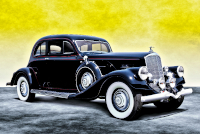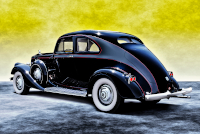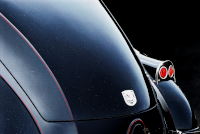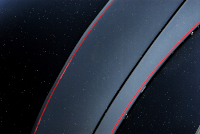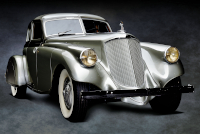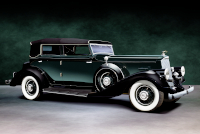Location:
Elegance at Hershey, 2012
Owner: Bill & Barbara Parfet | Hickory Corners, Michigan
Prologue:
I cruised by the V-12 Silver Arrow too quickly a dozen or so years ago, and just now returned to finish these illustrations and profile the car for the Pierce-Arrow portfolio. Looking about for companion material, I envy the images from this car's August 2020 auction listing, particularly the driver-side rear quarter perspective, which is perfect. The distance and proportion evident in that set depict the shape for its best attributes. My old photos seems basic in comparison, but that was a long time ago. Today's results are perky, if not precise, and at least enough fun to warrant some excitement.
- - - - - - - - - -
► Image Source: Nikon D200 (10.2 MP)
References:
- Ralston, Marc. "Pierce-Arrow" A.S. Barnes & Co., Inc., San Diego, CA. 1980, page 179-180, 232
- Automobile Quarterly, Volume 28, Number 4, Fourth Quarter 1990, "The Last Years of Luxury" by John C. Meyer III, The Kutztown Publishing Company, Inc., Kutztown, PA, page 97
- Pierce-Arrow Society, "Maurice A. Thorne Recalls his Days at Pierce-Arrow," transcribed by Bernie Weis, first published in The Arrow 1974-2, re-published in 2018-4, page 22
- Bring a Trailer: The auction listing for this Silver Arrow from August of 2020.
- Hyman Ltd: Not their usual to-do, but a few hints at the low production figures, though perhaps pertaining to V-12 cars only.
- Wikipedia: A check on the Startix automatic ignition system.
In providing context for the 840A Convertible Sedan by LeBaron, we discussed the bankruptcy reorganization terms for Pierce-Arrow and the untimely demise of its dealer network, leaving the factory without resources to sell its product, and with too many restrictions to meet demand. But the point is moot. Even by 1934, the age of the American classic is waning. Economic and global pressures squeeze the juice from these fruits before the close of the decade, and Pierce-Arrow is the bellwether.
So in this respect, 1934 is the end of the (all-too short) bounce-back from Pierce-Arrow's prior bankruptcy. And yet the company still enjoyed a rare spell of popularity that year. Of course what we see in the production version of the V-12 Silver Arrow is expedience in lieu of extravagance, but this is the flagship model that carries the latest innovations and the spirit of Pierce-Arrow's grandest accomplishments.
One of nine body styles offered across the V-12 1240A range, the Silver Arrow concept is now a coupe, not a sedan as was the 1933 show car. Cost pared back the streamlining for the production variant, though smaller elements carried through to 1934. Most notably, the faired-in tail lights will remain to the very end in 1938.
Pierce-Arrow Technical Refinement in 1934
If not so bombastic as the Silver Arrow show car, the 1934 production cars employed driver aids of electrical and mechanical refinement. These are not the trappings of Pierce-Arrow's land speed records, but improvements to further the company's reputation for the luxury driving experience. We previously noted that Pierce-Arrow debuted Stewart-Warner power brakes in 1933, which Ralston claims had no rival in the American market, and rather fit the model of contemporary Rolls-Royce cars.
The Pierce-Arrow Society write that Maurice Thorne, an experimental engineer at Pierce-Arrow, promoted the technology, setting up a car for Roy Faulkner to test. Thorne recalled, "I was very much sold on their effectiveness and asked Roy Faulkner to take a ride with me and try them out. After making some high-speed stops on the open road, I got him to drive on a thoroughfare that had numerous cars parked on each side of the street. Then I asked Roy to visualize a child darting out between two parked cars into the path of our car. Roy jumped the brake and stopped faster, I am sure, than at any time in his life. The power brakes were put into production." AQ also note an unexpected benefit of the power brake system is that the brake pedal became the same shape and height as the accelerator pedal, facilitating foot movement during panic maneuvers.
Another refinement entered in 1932 and featured through the end of production, that of the Startix automatic ignition system, which automatically re-starts the motor if it stalls. We discuss this system a bit more under the Technology section, and raise the topic here as the August 2020 auction listing for this Silver Arrow references the system's refurbishment. So I do not want to let the reference go unexplained.
In sum, the 1240A Silver Arrow is Pierce-Arrow's version of the consummate V-12 coupe—or at least the best version they can build given the grand reach of their vision and the tight constraints of their financial situation. The car is not so elegant as the original, or as precise in its detail. A big coupe, the production Silver Arrow relies on scale and technical refinement, not design, to earn its name and lead the Pierce-Arrow stable.
Motor: 7,570 cc (462 cubic inch) 80° V-12, cast-iron block | 88.9 mm x 101.6 mm (3½" x 4")
Valvetrain: L-head, 2 valves per cylinder, with self-adjusting hydraulic tappets
A word about the Startix automatic ignition system fitted to the 1934 Pierce-Arrow Twelve: Bendix Aviation Corporation manufactured the system for automotive use in the 1930s, often as an aftermarket accessory. (Lucas manufactured the system for the British market.) According to Wikipedia, which takes its source material from a February 1934 volume of MotorBoating describing the "Automatic Starter Relay," the system uses two solenoids. The first manages current from the battery to the starter and then within the conventional circuit of the alternator. That first solenoid also feeds "a second Startix solenoid that switches off the current from battery to starter." An interruption in the main circuit (the alternator) triggers the second solenoid, which switches on current from the battery to the starter. This system re-starts the car automatically if the motor stalls. Wikipedia note that the concept is similar to, if not the foundation of today's start-stop technology.
Aspiration: Stromberg dual downdraft carburetor
Power: 175 bhp @ 3,400 rpm
Drivetrain: 3-speed gearbox with freewheeling, rear-wheel drive
Front Suspension: solid axle, semi-elliptic leaf springs, friction dampers
Rear Suspension: live axle, semi-elliptic leaf springs, friction dampers
Architecture: steel ladder frame chassis with steel body over wood frame
Wheelbase: 3,657.6 mm (144 inches)
The Silver Arrow show cars used the smaller 139-inch wheelbase; they are four-door sedans. For the production version of the Silver Arrow concept, Pierce-Arrow turned to the 144-inch wheelbase, but then designed a two-door coupe on the longer platform. Given the change in dimensions and plan, the proportions of these later productions cars are necessarily far different than those of the original.
Etymology:
Between the 840A and the 1240A, the '8' and '12' refer to the straight-8 and V-12 motor options, whereas the '40' designation sits in the middle of the two chassis options, either a 139-inch or 144-inch wheelbase. This much is imprecise rationale, as the top-range 1248A uses the 147-inch wheelbase exclusively (but is no longer the Model 1247). So Pierce-Arrow numerology once again follows whimsical predilections, as the 1934 Model 1240A was preceded by the 1933 Model 1242, (losing two points of unknown value), whereas the 1934 Model 1248A was preceded in 1933 by the much more aptly named Model 1247.
The 'A' designation appended to all 1934 models is meaningless. There is no 'B' variation, and in 1935, all three of these Pierce-Arrow models will end in '-5,' (the Model 845, Model 1245, and Model 1255). And yes, the chassis and motor options remain the same. In this case, a 1933 Model 1242, 1934 Model 1240A, and 1935 Model 1245 is the same car built in three sequential model years, the same chassis with the same 175 horsepower V-12. Read in sequence, the 'A' can only have appeared in 1934 to appease buyers who noted that the number diminished from '42' to '40,' presuming that '40A' is somehow better.
The Salon Twelve moniker appears in Pierce-Arrow promotional material, though the factory seemed not to need the distinction, 'Eight' or 'Twelve' being sufficient. Such is the world of sales, and in this case the term is a slight Packardization of the model line.
The Silver Arrow name descends to the production line from the inimitable Silver Arrow show car of 1933, of which Pierce-Arrow built five. Impossible to replicate at scale, the production version is less an evocation of that eccentric art piece than a blunt nod for practical purposes.
Figures:
Ralston notes the factory produced 1,740 cars in 1934. Of those, few of Pierce-Arrow's conservative buyers opted for a V-12 Silver Arrow coupe. Hyman Ltd suggest Pierce-Arrow built 43 Silver Arrows in 1934 and just four more units in 1935, for a total of 47. Hyman state that 16 survive, 14 from 1934 and two from 1935. Hyman do not distinguish between the straight-8 and V-12 cars, though in other references of theirs the figures seem to pertain only to the V-12. (Pierce-Arrow did produce the Silver Arrow coupe as the 840A in 1934, and as the 845 in 1935). In this case, we might assume that 16 of these V-12 Silver Arrow cars survive, most of which are the 1934 Model 1240A. But indeed there are few Silver Arrows of any variety.
Big Coupe: Abandoning the Dimensions of the Silver Arrow Show Car
Although the production variant of the Silver Arrow uses a 144-inch wheelbase, five inches longer than the show car's chassis, the car is now a two-door coupe instead of keeping the original four-door sedan platform. Naturally, the proportions of the production variant are more top-hat-with-brim than the original concept, which is fully streamlined. Most notably, the original Silver Arrow uses a step-in plan with the body flush over the frame, advanced for the time, whereas the production variant uses conventional running boards and fenders. In this respect, the production Silver Arrow is a rather typical car of the time.
Beetle Back: Translating the Silver Arrow Fastback Shape to Production
More on-trend, the production Silver Arrow uses a fastback body style, though this application deviates from the show car in its complexity. The tail is neither as long nor as tapered, and a more conventional split-window replaces the bow-tie dormer of the original. More curious, the production car includes a crest moulded into the tail's center, a bit like a carved mantelpiece, with a 'Pierce 12' insignia in the middle. Of course the show car's dramatic taper-tail relies on shape and contrast, no such need for ornament. And so, where the Silver Arrow show car is a design whose every detail fits masterfully within the concept, the production variant's parting gesture feels something of an afterthought.
The fastback shape removes the C-pillars in favor of sweeping channels fed from the binding around the windows. On the original, this feature uses a compound shoulder line that flows continuously from the headlamps all the way to the tail, where the curves diminish and flow together. Not so complicated, the production variant uses conventional body moulding around the windows, merely drafting a single channel down the rear quarter sections. But these channels are contoured in deference to the original Silver Arrow, a slightly concave shape, and quite dissimilar from the Studebaker Commander Land Cruiser, (or most any classic coupe).
While the fastback body is the signature element that validates the Silver Arrow name, all 1934 production cars adopt the faired-in tail lights first seen on the show car. These light units complete the tail elegantly, without the clutter of separate fixtures, and will remain standard fair for all Pierce-Arrow cars through the end of production in 1938.
Studebaker Variant: Pierce-Arrow's Next-of-Kin Fastback Sedan
Opposite the Silver Arrow, Studebaker produced a limited number of Commander Land Cruiser sedans in 1934 and 1935, using a very similar tail design with extra quarter windows on the split rear glass. Both designs are legitimate Silver Arrow progeny, as a select Pierce-Arrow team assembled the original five show cars at the Studebaker factory. Silver Arrow show car development arrived at the end of the Studebaker partnership, and yet goodwill between the companies saw the project to fruition. By 1934, Studebaker no longer holds an interest in Pierce-Arrow, but can still use the Silver Arrow theme for its own trend-setting streamlined sedan.
Packard Silhouette: Counterpoint in Competition from Alexis de Sakhnoffsky
Also in 1934, Alexis de Sakhnoffsky uses the Packard Twelve chassis to join the fastback trend, creating the Twelve 1106 Aero Sport Coupe, built by LeBaron. In terms of proportion, the Packard coupe is much more the sporting cousin of the original Silver Arrow than Pierce-Arrow's own derivation. The 136-inch wheelbase of the 1106 is three inches shorter than the Silver Arrow show car, and so it better keeps the theme's diminutive expression, whereas Pierce-Arrow chose a larger chassis for its production coupe. The result is far less fantastic. Even the lesser Studebaker displays better proportion, to say nothing of de Sakhnoffsky's sense of whimsical curvature that makes the 1106 Aero Coupe such a tantalizing design. But for sustaining so much criticism, all of these fastback designs are quite rare, and each is special in its own right. Only that the 1934 Silver Arrow is perhaps special for what it represents more so than how it looks.
Last Updated: Mar 26, 2025

